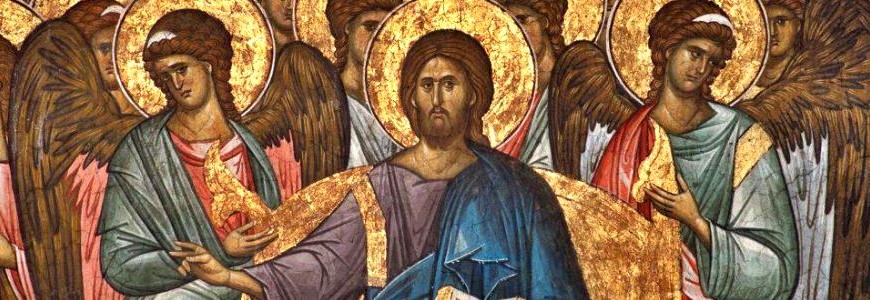
The word creed comes from the Latin credo which means “I believe.” In the Orthodox Church the creed is usually called The Symbol of Faith which means literally the “bringing together” and the “expression” or “confession” of the faith. The Creed was formally drawn up by the Church back in 325 AD and 381 AD after great controversies developed in Christendom about the nature of the Son of God and the Holy Spirit (click here to learn more). It is the Nicene-Constantinopolitan Creed, and is usually referred to simply as “the Nicene Creed.”
As the “Symbol of Faith” for Orthodox Christians, the Nicene-Constantinople Creed is recited by the faithful at every Divine Liturgy.
The Nicene Creed
I believe in One God, (Deuteronomy 6:4; Mark 12:29, 12:32; Ephesians 4:6; 1 Corinthians 8:6)
The Father Almighty (Genesis 17:1-8; Exodus 6:3; Matthew 6:9; Ephesians 4:6; 2 Corinthians 6:18)
Maker of heaven and earth (Genesis 1:1; Job 38:1-30)
And of all things visible and invisible (Colossians 1:15-16; John 1:3; Hebrews 11:3; Revelation 4:11)
And in one Lord, Jesus Christ (John 20:28; Acts 11:17, 16:31; 1 Corinthians 8:6; Ephesians 4:5)
The Son of God, the Only-Begotten (Matthew 3:17, 14:33, 16:16; John 1:14, 3:16)
Begotten of the Father before all ages (Psalm 2:7; John 1:1-2)
Light of Light (John 1:4, 1:9, 8:12; Psalm 27:1; Matthew 17:2, 5; 2 Corinthians 4:6; Hebrews 1:3; 1 John 1:5)
True God of True God (John 1:1-2, 17:1-5; 1 John 5:20)
Begotten, not made (John 1:1-2, 16:28, 1:18)
Of one essence with the Father (John 10:30)
By Whom all things were made (Hebrews 1:1-2, 10; John 1:3, 1:10; Colossians 1:16; 1 Corinthians 8:6; Romans 11:36)
Who for us men and for our salvation (I Timothy 2:4-5; Matthew 1:21; 1 Thessalonians 5:9; Colossians 1:13-14)
Came down from heaven (John 3:13, 3:31, 6:33-35, 38)
And was incarnate of the Holy Spirit and the Virgin Mary (Luke 1:34-35)
And became man (John 1:14; Hebrews 2:14)
And He was crucified for us (Mark 15:25; I Corinthians 15:3; 1 Peter 2:24)
under Pontius Pilate (Mark 15:15)
And suffered (Mark 8: 31; Matthew 27:50)
And was buried (Luke 23:53; 1 Corinthians 15:4; Matthew 27:59-60)
And He rose again on the third day (Mark 9:31, 16:9; Acts 10:40; 1 Corinthians 15:4)
According to the Scriptures (Luke 24:1, 45-46; 1 Corinthians 15:3-4)
And ascended into heaven (Luke 24:51; Acts 1:9-10; Mark 16:19)
And sits at the right hand of the Father (Mark 16:19; Acts 7:55; Luke 22:69)
And He will come again with glory (Matthew 24:27; Mark 13:26; John 14:3; 1 Thessalonians 4:17)
To judge the living and the dead (Acts 10:42; 2 Timothy 4:1; Matthew 16:27; 2 Corinthians 5:10; 1 Peter 4:5)
His kingdom shall have no end (2 Peter 1:11; Hebrews 1:8)
And I believe in the Holy Spirit (John 14:26; Acts 1:8)
The Lord and Giver of life (Acts 5: 3-4; Genesis 1:2; John 6:63; 2 Corinthians 3:6)
Who proceeds from the Father (John 15:26)
Who together with the Father and the Son is worshipped and glorified (Matthew 3:16-17)
Who spoke through the prophets (I Samuel 19:20; Ezekiel 11:5; 1 Peter 1:10-11; Ephesians 3:5)
And I believe in one, holy, catholic and apostolic Church (Matthew 16:18, 28:19; 1 Peter 2:5,9; Ephesians 1:4, 2:19-22, 4:4, 5:27; Acts 1:8, 2:42; Mark 16:15; Romans 12:4-5; 1 Corinthians 10:17)
I acknowledge one baptism for the remission of sins (Ephesians 4:5; Galatians 3:27; 1 Corinthians 12:13; Colossians 2:12-13; Acts 22:16)
I look for the resurrection of the dead (John 11:24; 1 Corinthians 15:12-49; Romans 6:4-5; 1 Thessalonians 4:16)
And the life of the world to come. (Mark 10:29-30; 2 Peter 3:13; Revelation 21:1)
Amen. (Psalm 106:48)
And here is what is sounds like on Sunday morning, when we sing it.
This is the historical definition of Christian belief. In other words, if you don’t believe this, you are not a member of the Christian faith.